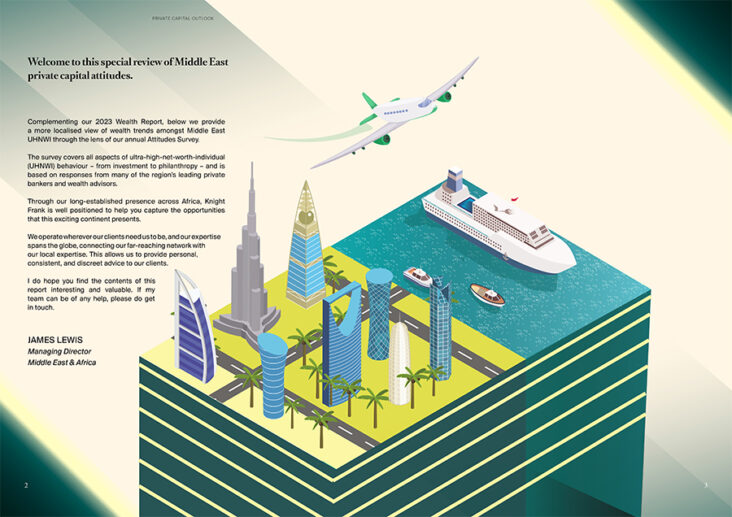Dubai Emerges As World’s Fourth Most Active Luxury Residential Market

Dubai’s prime residential market has emerged as the fourth most active in the world, according to global property consultant, Knight Frank’s 2023 Wealth Report.
Knight Frank defines Dubai’s prime residential areas as The Palm Jumeirah, Emirates Hills and Jumeirah Bay Island.
According to Knight Frank’s research, with 219 US$10 million+ home sales during 2022, Dubai ranks just behind New York (244 sales), Los Angeles (225 sales) and London (223 sales).
The city’s stellar rise is further evidenced by the fact that Dubai is now the fifth most active city for US$ 25 million home sales as well, with 26 last year – only London (43), New York (43), Los Angeles (39) and Hong Kong (28) rank higher.
AFFORDABLE LUXURY
Faisal Durrani, Partner – Head of Middle East Research explained: “Dubai has arrived. The emirate has taken its place among long-established hub cities as one of the world’s most sought-after luxury residential markets.
“The growing concentration of wealth in the city has been catalysed the confluence of factors, ranging from the government’s decisive response to the pandemic, to the roll-out of a range of new residency visa options. Of course, the fact that Dubai’s luxury residential market remains significantly undersupplied – just 8 new villas are expected in the city’s prime neighbourhoods until 2025 – and is more affordable than its global counterparts is also adding to the overall appeal of owning a home in Dubai amongst the world’s elite. Indeed, US$ 1 million in Dubai’s prime residential precincts translates into approximately 1,130 square feet of space, roughly five-times more than Hong Kong and three-times more than London or Singapore.
“These factors have fuelled business and economic confidence and have in turn helped to supercharge demand for luxury homes”.
Knight Frank also points to the diversity in Dubai’s buyer base, which has contributed to the overall market’s performance.
Andrew Cummings, Partner – Head of Prime Residential said: “With the strongest prime residential growth rate in the world forecast this year at 13.5%, Dubai’s market still represents outstanding relative value. It is this value that continues to drive UHNWI buyers into our market, most of whom are seeking a sun-sand-sea lifestyle that is now synonymous with Dubai. The city’s appeal stretches right across the world, but in 2022, we saw a resurgence of investment from our traditional long-time stalwarts of the buyer nationality league table. This showed continued interest from the UK and India, as well as Europeans that had slowed down but picked up in 2022. Chinese investors have also bounced back post-pandemic, making Middle East residential investments very lucrative.
The rapid return to normality following the pandemic also attracted numerous businesses from Europe, the UK and Asia to establish offices here, or relocate their headquarters altogether, which has given rise to buyers from new markets such as Monaco, Switzerland, Singapore and Hong Kong”.
MIDDLE EAST WEALTH TRENDS
Knight Frank’s 2023 Wealth Report also includes findings of its annual Attitudes Survey. 500 private bankers, wealth advisors and family offices were interviewed around the world, with respondents in the Middle East naming the UK (85%) the most popular residential investment target for 2023. The UAE (48%) is ranked second, with the USA (37%) following in third place. France and Switzerland round out the top five.
37% of ultra-high-net-worth individuals (UHNWIs) in the Middle East grew their wealth in 2022 by more than 10%, according to Knight Frank’s Attitudes Survey, despite it being a year of slow global growth post the pandemic. This surpasses the global average of 17%. Middle East respondents also appear to be more exposed to global markets, holding an average of 5.3 homes in international markets, above the global average of 4.2.
Shehzad Jamal, Partner – Head of Strategic Consulting – UAE, Real Estate, Healthcare and Education, added: “The other discernible difference in investment strategies between Middle East UHNWI and their global counterparts is their apparent heavier weighting towards offices. At 63%, offices form the single largest non-residential sector of preference for Middle East UHNWI, well above the global average of 43%. Logistics and Industrial (41%) follow in second place.
“With key cities in the Middle East such as Dubai, Abu Dhabi and Riyadh experiencing rising office and warehouse demand against a backdrop of record high occupancy levels and a restricted development pipeline, it is easy to see why offices and warehouses are attractive targets for some”.


